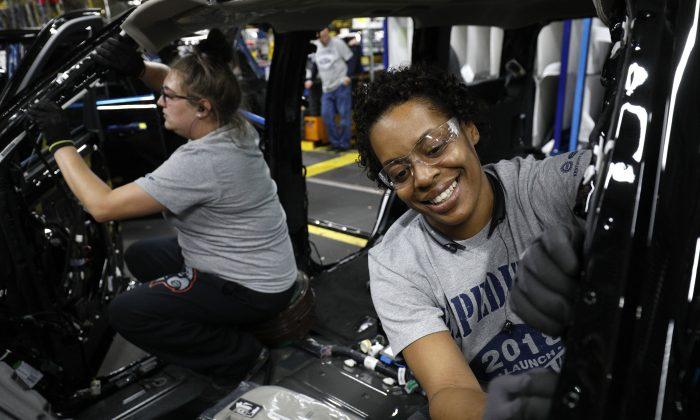WASHINGTON—The number of Americans filing new claims for unemployment aid fell to near a 49-year low last week and private payrolls rose steadily in August, pointing to sustained labor market strength that should continue to underpin economic growth.
The economy so far appears to be weathering an escalating trade war between the United States and China as well as tensions with other trade partners, including Canada, the European Union, and Mexico, which have rattled financial markets.
This likely keeps the Federal Reserve on track to raise interest rates this month for the third time this year.
“The economy is in overdrive with jobless claims at lows not seen since the 1960s, and this gives the Fed the green light to raise interest rates later this month and take away some of the economy’s punch,” said Chris Rupkey, chief economist at MUFG in New York.
The Labor Department said on Sept. 6 initial claims for state unemployment benefits dropped 10,000 to a seasonally adjusted 203,000 for the week ended Sept. 1, the lowest level since December 1969.
Economists polled by Reuters had forecast claims rising to 214,000 in the latest week. The four-week moving average of initial claims, considered a better measure of labor market trends as it irons out week-to-week volatility, fell 2,750 last week to 209,500, also the lowest level since December 1969.
Though there have been reports of some companies either planning job cuts or laying off workers because of uncertainty caused by the U.S. administration’s trade policy, that has not yet been reflected in the claims data.
Economists say given labor market tightness, employers were reluctant to lay off workers. The labor market is viewed as being near or at full employment.
Strong Job Growth
Separately, the ADP National Employment Report showed private payrolls increased by 163,000 jobs last month. Data for July was revised to show private hiring rising by 217,000 jobs instead of the previously reported 219,000 positions.Economists polled by Reuters had forecast private payrolls increasing by 190,000 jobs last month. The ADP report, which is jointly developed with Moody’s Analytics, was published ahead of the government’s more comprehensive employment report for August, which is due on Sept. 7.
Though the ADP report has a spotty record predicting the private payrolls component of the employment report, economists said the August data hinted at some slowing in job growth.
“Employment growth is still well above the pace needed to absorb new entrants into the labor force, meaning that the unemployment rate, which is already unusually low, should continue to decline gradually,” said Paul Ashworth, chief U.S. economist at Capital Economics in Toronto.
According to a Reuters survey of economists, nonfarm payrolls likely increased by 191,000 jobs in August, which would be an acceleration from the 157,000 jobs created in July. The unemployment rate is forecast slipping one-tenth of a percentage point to 3.8 percent, revisiting an 18-year low touched in May.
Should the August employment report meet market expectations on Sept. 7, that would likely seal the case for a rate increase at the Fed’s Sept. 25-26 policy meeting.
The economy grew at a 4.2 percent annualized rate in the second quarter, the fastest in nearly four years. Consumer and business spending data in July have suggested solid economic growth early in the third quarter. But there are concerns the trade tensions could hurt confidence and undercut spending.
The economy’s vibrancy was underscored by a report on Sept. 6 from the Institute for Supply Management (ISM) showing its non-manufacturing activity index increased 2.8 points to 58.5 last month. A reading above 50 indicates expansion in the sector, which accounts for more than two-thirds of U.S. economic activity.
The ISM survey said respondents to its survey remained positive about business conditions and the economy, but cautioned that “logistics, tariffs, and employment resources continue to have an impact on many of the respective industries.”
While a fourth report from the Commerce Department showed factory goods orders dropped 0.8 percent in July amid weak demand for aircraft, business spending appeared to be picking up early in the third quarter. Orders rose 0.6 percent in June.
July orders for non-defense capital goods excluding aircraft, which are seen as a measure of business spending plans, jumped 1.6 percent instead of increasing 1.4 percent as reported last month. Orders for these so-called core capital goods rose 0.8 percent in June.
Shipments of core capital goods, which are used to calculate business equipment spending in the gross domestic product report, increased 1.0 percent in July instead of climbing 0.9 percent as reported last month.
Core capital goods shipments rose 1.0 percent in June. Business spending on equipment slowed in the second quarter after growing robustly since the first quarter of 2017.
A fifth report from the Labor Department showed nonfarm productivity, which measures hourly output per worker, increased at an unrevised 2.9 percent annualized rate in the April-June quarter. That was the strongest pace since the first quarter of 2015. Productivity grew at a 0.3 percent rate in the first quarter.






Friends Read Free